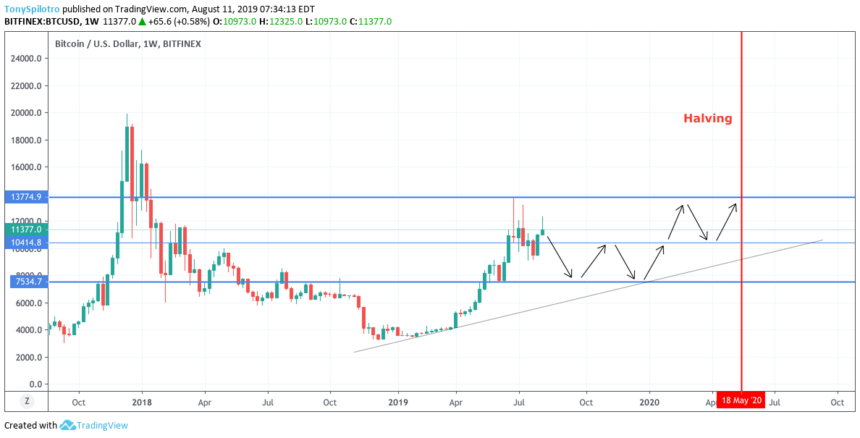Bitcoin analysts that populate Twitter take great pains in plotting every possible near-term movement that their beloved digital asset might traverse over the ensuing weeks, tapping into their favorite technical indicators and citing all manner of fundamental causes that will drive the price action. While the majority points to actions taken by Fidelity Investments, the Bakkt exchange, and, more recently, the “safe haven” nature that has been conferred upon BTC, a small subset debates the impact of next year’s “halving” event, as the key motivator for positive momentum on the road ahead.
For those that missed the email, a “halving” event occurs every four years for Bitcoin. During its first four years of existence, 50 bitcoins were issued every ten minutes, a mining “reward”, so to speak. Every four years, this amount is cut in half, which has earned the name of a “halving event”. As of 17 May 2020, the mining reward will be cut in half again, from its present amount of 12.5, down to 6.25. The argument follows that, as fewer BTC are issued and if all things remain equal, existing demand will drive prices northward, based on the basic supply and demand dynamics in a marketplace.
One analyst, Tony Spilotro, has taken his consummate skills and constructed the following weekly BTC chart, as his best guess as to what the future holds for Bitcoin:
Mr. Spilotro’s hypothesis is that Bitcoin will be range bound in two separate “tiers”, each with a width of roughly $2,000. The lower tier will be the result of its present downward trend line of lower highs and lower lows on the weekly chart. The boundaries will exist at $7,500 and $9,500. When it is six months before the halving date, Bitcoin will bound forward to the second tier, approaching $13,775 at its apex.
The logic appears sound, from a technical perspective. The initial bounce to come in late September does take on the look of a traditional 5-phased impulse wave from Elliott Wave textbooks. If that were the case, we could add that the correction wave would follow the halving event and drop back down to the diagonal support line, which would produce a $10,400 price point.
Is there another halving example, which could verify or dispute this forecast? As a matter of fact, there is. Litecoin just completed a halving event on the 9th of August. Analysts have frequently stated that Litecoin (LTC) has outperformed Bitcoin in 2019, providing higher returns over similar periods. The LTC “premium”, if you will, is evident when viewing a “LTC vs BTC” chart. Since December, one Litecoin was equivalent to 0.007 BTC. At its peak, one LTC could buy nearly 0.018 BTC, but in early June, the so-called premium began to evaporate. One LTC now buys 0.075 BTC, about where it started.
In a recent interview, “PZ”, the general secretary of the Litecoin Roundtable Forum, spoke to this halving phenomenon. He remarked that: “The wave of the small bull market brought by Litecoin’s halving is a preview of the big bull market in the next year [for Bitcoin]. If there is no special industrial black swan, there will be a brilliant situation next year.” As you might expect, when the mining reward declined, the financial impact was to reduce overall computing power, which precipitated a price drop.
When you inspect Litecoin’s chart in isolation, its dramatic rise began six months ahead of its halving. Its multiple at its peak was roughly “5.5X”. Two months ahead of the halving, the “sell-on-the-approaching-news” began to take place. LTC fell from $139, down to $86, as of today, still a multiple since December of “3.4X”. What if, all things being equal, BTC followed a similar path? In this case, Bitcoin would peak at $17,200 at mid-March, then fall to $10,800 afterwards.
These figures are quite different than Mr. Spilotro prophesizes, but this exercise only shows that anyone can use logical algorithms to arrive at very differing forecasts of future events. The actual result could fall somewhere in between, or even outside of these predictions for that matter. Bitcoin will always beat to its own drummer, which in the past has ignored technical certainties on several occasions. Goldman Sachs posited this week that Bitcoin could rise to nearly $14,000, after the current correction passes. Whatever the outcome, the road ahead will definitely be an interesting one.

